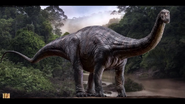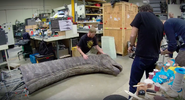| Apatosaurus (Jurassic Park) | |||
|---|---|---|---|

| |||
| Naming | |||
| Binomen | Apatosaurus sp. | ||
| Morphology | |||
| Average height | 5 meters (16-17 feet) | ||
| Average length | 22-27 meters (75-90 feet) | ||
| Average weight | 20-36 tons | ||
| Intelligence | |||
| Sapience | Non-sapient | ||
| Aggressivity | Very Low | ||
| Ecology | |||
| Place of origin | Earth | ||
| Habitat | Isla Nublar | ||
| Diet | Herbivore | ||
| Locomotion | Movement using four legs | ||
| Status | Data Deficient | ||
| Behind the Scenes | |||
| Universe | Jurassic Park | ||
| Performed by | Harris Hawk vocals[1] Recycled Brachiosaurus sounds | ||
The Apatosaurus is one of the most famous of the giant Jurassic plant-eaters of Isla Nublar
Story
Apatosaurus was recreated by InGen for the Masrani Global Corporation's Jurassic World, their new dinosaur zoo. Apatosaurus has gray skin with dark blue striping and dark tan on its underbelly and portions of its face. Much like the cloned Brachiosaurus, it chewed its food unlike the original Apatosaurus.
Their herds lives in the Gallimimus Valley, the Gyrosphere, and the Cretaceous Cruise, alongside Stegosaurus, Microceratus, and 100 other prehistoric species. Some of the juveniles also lived in the Gentle Giants Petting Zoo
Gallery
Notes
- In the script for Jurassic Park, Apatosaurus is listed as one of the embryos that Dennis Nedry steals in scene 49.
- Apatosaurus was originally going to be one of the dinosaurs that can be created in the video game Jurassic Park: Operation Genesis, but was cut from the final product for unknown reasons.
- The Apatosaurus skull seen on the Jurassic World website does not belong to the dinosaur at all, rather it belongs to a brachiosaurid sauropod like Brachiosaurus. Furthermore, its icon on the Jurassic World website and the Holoscape is of Brachiosaurus as well.
- In the storyboard for Jurassic World Apatosaurus' relative Diplodocus was originally supposed to appear before Apatosaurus was chosen.
- The scene where the apatosaur is seen dying is one of the very few animatronics used in Jurassic World.
- The sauropod's skin was based on references from rhinoceros and elephants.
References
<references>


